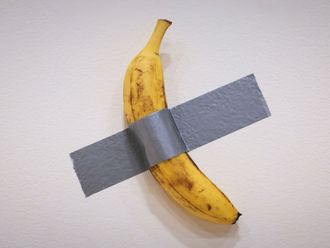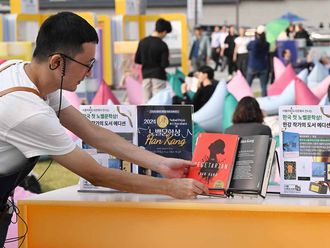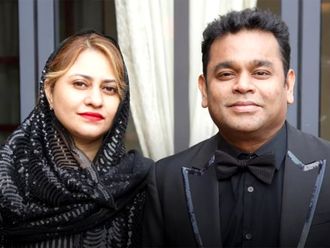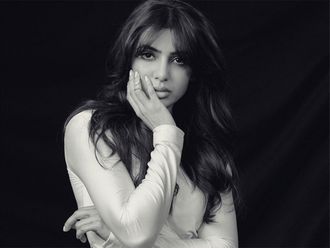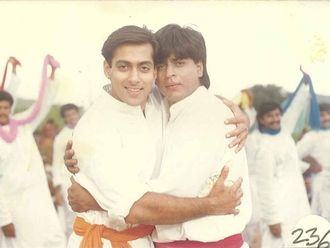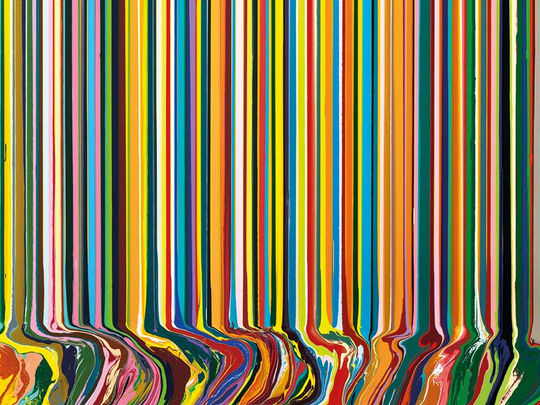
Ian Davenport is well known for his contemplative, abstract paintings created by dripping paint on metal panels in a carefully orchestrated symphony of colours. In his first exhibition in Dubai, Cascade , the British artist continues his experimentation with materiality, liquidity, colour relationships, timing and chance. He is presenting new works where he has taken his dripping technique further to incorporate the puddles of paint formed at the bottom of the panels as a sculptural element in the work. The show also includes recent ‘splatter’ paintings on paper, and some ‘Circle Paintings’ from the early 2000s.
Davenport graduated from Goldsmiths College of Art, London, in 1988. The same year he participated in Freeze, an exhibition at the Surrey Docks in London Docklands, curated by his fellow students. His work was well received, and he became part of a group that came to be known as the YBAs (Young British Artists). The group which included Goldsmiths’ students such as Damien Hirst and Tracy Emin drew international attention to British art through their experimentation with new materials and techniques and artist curated exhibitions at unconventional venues.
Davenport became the youngest artist to be nominated for the Turner Prize in 1991 when he was 25, and in 1999 he was awarded the John Moores Painting Prize. His work is in the collections of prestigious museums around the world, and he has also created many public installations, including a 48-metre-long painting titled Poured Lines on Southwark Street, London.
Earlier this year, he created a monumental ‘poured’ painting complete with puddles on the floor, titled Giardini Colourfall for the 57th Venice Biennale as part of a commission from Swatch. The project also included designing a limited-edition watch for the company. Other media he has explored through commissions include a hand-painted series of porcelain plates in collaboration with Meissen, a limited-edition Dior bag, and a design project for the Olympic games in London with Fabergé.
The artist spoke to the Weekend Review about his work and his journey. Excerpts:
How did you develop this technique of poured lines?
My journey is essentially about exploring materials and lines. After graduating from art school, I wanted to explore what I can make paint do and find my own language. I tried many different techniques such as using an electric fan to blow paint onto my canvases, using paint cans to create circle paintings, and playing with different types of paints and techniques of pouring and dripping to investigate abstract notions of rhythm, chance and mark making.
These experiments led to my current technique of pouring paint from a syringe and letting it flow down in a controlled way on aluminium or steel panels. I use acrylic paint mixed with a special medium that allows it to dry slowly. These simple compositions of vertical bands of colour offer a vehicle for exploring the resonance between colour fields and sequences.
How do you choose the palette?
I began by selecting the colours intuitively and mostly used a muted and monochromatic palette, but later I felt the need to free my work from the dictates of my colour sense, and have something else to react to. I looked for inspiration in the landscape, but finally found it in the works of famous masters. For instance, in this show, the colours in Cobalt Blue Water are based on Monet’s Water Lilies, and the softer palette in Hail: Blue, Grey is taken from Paul Gauguin’s painting Hail Mary.
Similarly, my palette in Mirrored Place is inspired by a landscape by Pierre Bonnard; and the two paintings titled Magenta Portrait and Yellow Portrait reflect the colours in the portraits of Eugene Primavesi and her nine-year-old daughter Mada Primavesi painted by Gustave Klimt in 1912. By hanging these paintings next to each other I have reunited the mother and daughter whose portraits have been in different collections for many years.
How has your dripping technique evolved?
In some of the works in this show, I used a panel that was bent at the bottom, and straightened it out after pouring the paints so that the vertical bands are twisted and merged towards the end. In others such as Mirrored Place and Cobalt Blue Water, I allowed the puddles of paint to collect on a floor piece and then cut the metal around them making the intricate swirling patterns on the floor a part of the artworks, thus adding a sculptural element and horizontal plane to the installation.
How were the paintings titled Splat Attack created?
The idea for these paintings came from a workshop I did for children. They started splashing the paint around and I liked the energy, so I tried to recreate that by using syringes to splatter paint on paper. The splats look like an explosion of fireworks in the sky and offer a counterpoint to the more controlled poured paintings.
What were the circular paintings about?
I built up the lines by pouring household paint flat and letting it flow till it formed a big circle, flipping it upside down to remove the excess paint and then flipping it back. It was about thinking about colour, gravity, what materials do, and really looking at the world we live in — at things such as the idea that we live on a planet that is spinning. It was my way of exploring the world and making sense of it.
What was the impact of being nominated for the Turner Prize so early in your career?
It was a huge honour to be nominated along with leading artists of the time. It helped to catapult me into the art world and have my work taken seriously. But there was also the pressure of growing up in public. I had never had that level of criticism on such a public stage and it was difficult to deal with that. But I learnt that rather being confused by the opinions of others I must trust my own instincts, question myself and go with what compels me and gives me energy.
In a technology driven world what keeps you interested in a traditional medium like painting?
I love painting and that is what I want to do, but modern technology helps me a lot in my work. Being able to download hi-res images of famous paintings from museum collections allows me to study them closely. While doing the studies for my paintings I use digital manipulation to play around with the colours and sequences. And social media is a great help in taking my work to a wider audience.
Having been part of the YBAs, what advice would you give to young artists of today?
To be an artist is a unique privilege and must not be taken for granted. You need to work hard and be very stubborn, and you must travel, visit museums and galleries and look at art from around the world. Make sure you have people around you who can critique your work and help you grow. But most importantly enjoy what you are doing.
Cascade will run at Custot Gallery Dubai, Alserkal Avenue, Al Quoz, until March 3, 2018.



